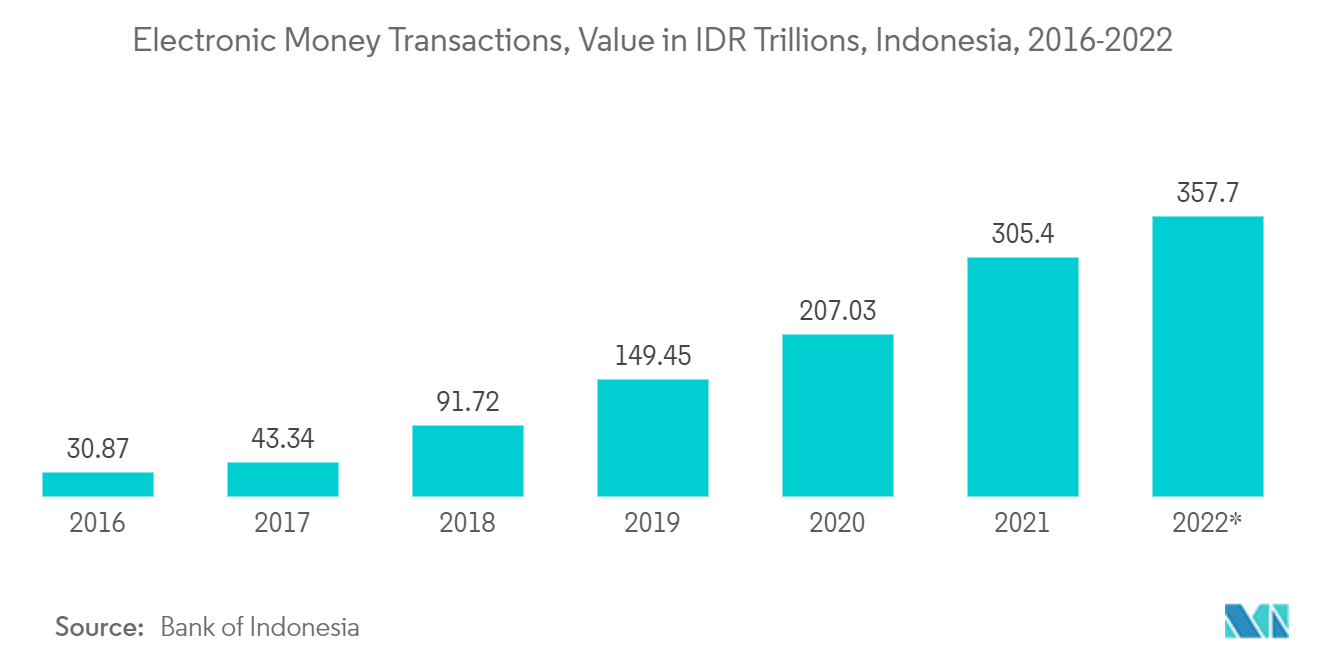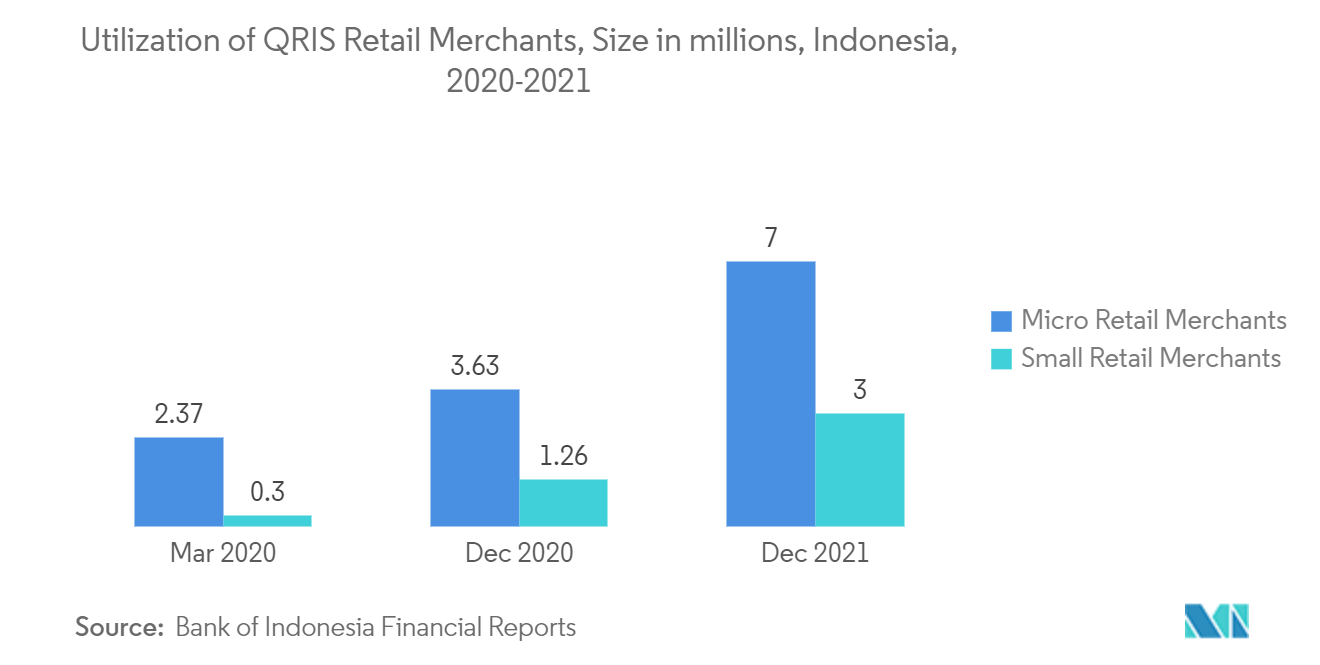Market Trends of Indonesia Mobile Payments Industry
This section covers the major market trends shaping the Indonesia Mobile Payments Market according to our research experts:
Rise in e-Wallet Platforms Drives the Market
- Consumers in Indonesia are highly open to new offerings in the digital economy. The market for fintech goods is expanding in Indonesia, as seen by the growth in the volume of transactions and the number of companies. According to Bank of Indonesia statistics, digital banking transactions in Indonesia increased 47% YoY through November to 3,877 trillion rupiahs (USD 269.52 billion), mostly as a result of the current COVID-19 pandemic's global expansion.
- In the third quarter of 2021, the value of payment transactions made using electronic money and digital banking increased by 52.5 percent (YoY) and 60.7 percent (YoY), respectively. The development and simplicity of digital payment systems, the acceleration of digital banking, and the growing public preference for online shopping all contribute to the rapid growth of digital transactions.
- Further, the Indonesian government authorities have authorized 41 licensed e-Wallet systems as of February 2020; in October 2019, SamsungPay joined the Indonesian market, which was a notable development for a foreign fintech company. Nearly half of Indonesia's population-102 million people-grew from 64 million to 102 million digital customers between 2017 and 2018. Online shopping is expected to expand 3.7 times from 13.1 billion USD in transactions in 2017 to 48.3 billion USD in 2025 due to the rise of digital customers.
- In the previous two years of 2021, the number of e-wallet apps held by internet-based businesses climbed by 50%. GoPay, DANA, Paytrend, and DOKU are four of these businesses that are in the top 10 e-Wallet apps in Indonesia. Three-quarters of Indonesia's 260 million people still lack access to basic financial services. Therefore the country's regulator, the Financial Services Authority (OJK), promoted this expansion to strengthen the economy of the nation. Jenius from BTPN, Go Mobile by CIMB from CIMB, and Sakuku from BCA are three of the top 10 most downloaded e-Wallet apps that are owned by banks.
- Also, some overseas e-Wallet providers have expressed interest in the digital payment sector in Indonesia. WeChatPay, AliPay, and WhatsApp Pay are keeping an eye on market growth. Any international competitor looking to break into the Indonesian e-Wallet industry must collaborate with a regional bank known as Buku 4 (BUKU 4 - Bank Umum Kegiatan Usaha). Seven banks in Indonesia are now designated as BUKU 4 banks: BNI, Mandiri, BRI, BCA, CIMB Niaga, Bank Danamon, and Bank Panin for cross-border e-Wallets through the Bank of Indonesia. The usage of Indonesian money with QRIS and compliance with the Standardization of Open Application Programming Interface are requirements for foreign-invested e-Wallet systems.

Retail to Hold Significant Share
- Under the theme "Payment System Digital Transformation to Accelerate National Economic Recovery," Bank Indonesia virtually introduced the Bank Indonesia Fast Payment (BI-FAST) system. For the purpose of facilitating retail payment transactions for the general public, Bank Indonesia has established the BI-FAST payment system infrastructure, which is accessible through apps given by the payment system industry. In accordance with each bank's strategy to provide its clients with a variety of payment methods, BI-FAST is being gradually pushed out to its consumers.
- According to BI statistics, digital banking transactions in Indonesia increased 47% y/y through November to 3,877 trillion rupiahs (USD 269.52 billion), mostly as a result of the current COVID-19 pandemic's global expansion.
- As compared to the existing interbank money transfer fee of 6,500 rupiahs (46 cents) for each transaction, the new BI-Fast system offers consumers real-time, secure money transfers of up to 250 million rupiahs (about USD 170,000) for a maximum cost of 2,500 rupiahs (17 cents) per transaction.
- The most widely used fintech service in Indonesia is electronic money, sometimes known as e-Wallet payments. This is followed by web-based investing and pay-later services. As Indonesia moves closer to a cashless society, electronic money transactions in the country's retail sector increased by 173 percent in January 2020 compared to the same month the previous year. Nonbank fintech dominated the market, where e-money transactions were IDR 15.8 trillion. The biggest digital transactions in Indonesia are in retail (28%), online transportation (27%), meal ordering (20%), e-commerce (15%), and bill payments (7% ).
- Especially among MSME and retail merchants, the national and regional initiatives to spread Quick Response Code Indonesian Standard (QRIS) have advanced the digital economy and finance. Since its introduction in August 2019, Bank Indonesia has conducted a significant public relations effort to raise awareness of QRIS as Indonesia's only digital payment standard.
- Moreover, the value of payments made using electronic money and digital banking in Indonesia has increased significantly year over year to 58.70% (YoY) and 42.90% (YoY) and will increase to 49.06 percent (YoY) and 45.64 percent (YoY) in 2021, respectively. It is strengthened by the QR Code Indonesian Standard (QRIS) ecosystem's growth, which has surpassed the goal of 12 million merchants in 2021 and is primarily driven by a rise in Micro businesses and Small businesses.

